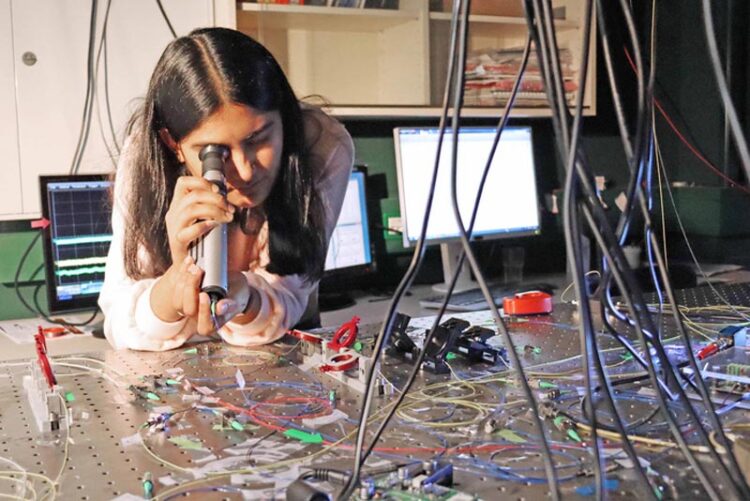Hotter than infinity – light pulses can behave like an exotic gas

PhD student Monika Monika at the set-up where the experiments were conducted.
Credit: Ira Winkler/University Jena
Physicists at the Universities of Jena and Central Florida investigate light with negative temperatures.
In the issue of the renowned journal Science published today (10.3.23), the team led by Prof. Dr Ulf Peschel reports on measurements on a sequence of pulses that travel thousands of kilometres through glass fibres that are only a few microns thin. The researchers were surprised by the results. “We have found that the light pulses organize themselves after about a hundred kilometres and then behave more like molecules of a conventional gas, such as air, for example”, reports Prof. Ulf Peschel, the head of the group in Jena. In a gas the particles move back and forth at different speeds, but still they have a mean velocity defined by their temperature. Although light pulses propagate through the glass fibre at an average speed of about 200,000 kilometres per second , they are not all equally fast. “The statistical distribution of their velocities equals exactly that of a conventional gas with a fixed temperature”, says Peschel.
As the researchers have now demonstrated for the first time in their recent publication, this photon gas can be cooled, for example, by a process known as adiabatic expansion. As in a real gas, the velocity differences of the particles decrease during cooling and the order in the signal sequence automatically increases. When the absolute temperature zero of 0 Kelvin is reached, all pulses propagate at exactly the same velocity.
The reverse process is also possible. “When the optical gas is heated, velocity differences increase”, explains Peschel. If all pulse velocities occur equally often, the disorder is at a maximum and the temperature is infinite – a state which cannot be reached in a real gas as it would require an infinite amount of energy. “In contrast, a periodic modulation of the refractive index can limit the range of allowed pulse velocities in the glass fibre. In this way, all available velocity states can be equally excited, creating a photon gas of infinite temperature. If even more energy is added, states of extreme velocities are preferentially populated – the photon gas becomes hotter than infinitely hot.
“For this state, which has so far only been described theoretically for light, a temperature below absolute zero is mathematically assumed”, says Peschel. He and his colleagues have now been able to create such a photon gas with negative temperature and show for the first time that it obeys conventional laws of thermodynamics. “Our results will contribute to a better understanding of the collective behaviour of large ensembles of optical signals. If we take the laws of thermodynamics into account, we can make optical data transmission more robust and reliable, for example by structuring pulse distributions to better match thermal distributions.”
Journal: Science
DOI: 10.1126/science.ade6523
Method of Research: Experimental study
Article Title: Observation of photon-photon thermodynamic processes under negative optical temperature conditions
Article Publication Date: 10-Mar-2023
All latest news from the category: Physics and Astronomy
This area deals with the fundamental laws and building blocks of nature and how they interact, the properties and the behavior of matter, and research into space and time and their structures.
innovations-report provides in-depth reports and articles on subjects such as astrophysics, laser technologies, nuclear, quantum, particle and solid-state physics, nanotechnologies, planetary research and findings (Mars, Venus) and developments related to the Hubble Telescope.
Newest articles

A universal framework for spatial biology
SpatialData is a freely accessible tool to unify and integrate data from different omics technologies accounting for spatial information, which can provide holistic insights into health and disease. Biological processes…

How complex biological processes arise
A $20 million grant from the U.S. National Science Foundation (NSF) will support the establishment and operation of the National Synthesis Center for Emergence in the Molecular and Cellular Sciences (NCEMS) at…

Airborne single-photon lidar system achieves high-resolution 3D imaging
Compact, low-power system opens doors for photon-efficient drone and satellite-based environmental monitoring and mapping. Researchers have developed a compact and lightweight single-photon airborne lidar system that can acquire high-resolution 3D…





















